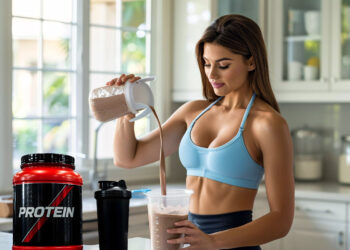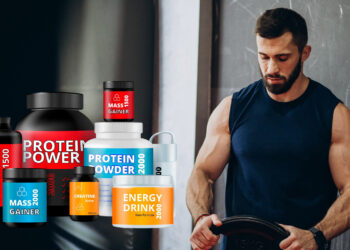There’s no debating the incredible effects of creatine, a substance produced by the body that is also found in red meats and seafood. It’s stored mostly in muscles where it’s used as an energy source, but it’s also found in the brain, liver, and kidneys.
But even if the body produces it, and even if you eat a decent amount of creatine-containing foods, supplementation is the best way to maximize the muscle building, strength increasing, and performance improving benefits of creatine. Now, there are various forms of creatine, with monohydrate being the most studied and proven. And you can actually get faster results from monohydrate by utilizing a method called loading. So today, we’re going to explain how to load creatine for maximum benefit (1).
What Is Creatine and How Does It Work

To understand why loading creatine is beneficial, you must first understand what creatine does in the body or how it works.
Creatine is an amino acid that is converted in the body into a substance called phosphocreatine, of which 95% of it is stored in the muscles, and 5% is stored in the brain, kidneys, and liver (2).
What is Phosphocreatine? It’s a phosphorylated creatine molecule that acts as a high-energy reserve of phosphates that are capable of regenerating adenosine triphosphate (ATP), which is the “energy currency of the cells”.
Level Up Your Fitness: Join our 💪 strong community in Fitness Volt Newsletter. Get daily inspiration, expert-backed workouts, nutrition tips, the latest in strength sports, and the support you need to reach your goals. Subscribe for free!
ATP is essential for driving muscle contractions and other physiological processes. During high-intensity activities, the body uses up ATP very quickly, and consequently, it needs to be regenerated to support said activities. And because creatine fuels the production of ATP, this provides a means for the muscles to perform in the absence of oxygen during high-intensity training (very important) (3).
Supplementing creatine allows the body to create much more ATP than what the body can produce or what you can get through nutrition. In fact, eating creatine-containing foods will only cause your muscles to store about 60-80% creatine while using supplements will maximize the creatine stores in your muscles.
Creatine also increases fluid in the muscles (cell volumization) that increases muscle growth and strength, and it can stimulate muscle growth via various pathways, in addition to increasing insulin-like growth factor-I (IGF-1) (4, 5, 6, 7).
According to research, creatine may also possess neuroprotective properties because low levels of creatine can negatively affect cognitive function and cause other issues. It may also be helpful for many health conditions such as sarcopenia (age-related muscle loss), Parkinson’s, and much more. But the studies are less conclusive than for what we already know it to be most beneficial (8).
OK, so now that you know the basics of creatine, let’s talk about the method of loading for faster muscle and strength gains.
What is Creatine Loading?
Before we explain how to load creatine, you’ll probably want to know what it involves if you don’t already.
Loading creatine typically involves taking a higher initial daily dose such as 20 grams over the span of the first 4-7 days of supplementation to saturate your muscles with it. This should allow your muscles to reach their storage limit and as a result, allow it to have greater initial effects.
Then after the loading phase, you’ll take anywhere from 1-20+ grams per day as part of the maintenance dose or phase. Although a common maintenance dose is about 2-10 grams per day for most users whether for building muscle, increasing strength, or preventing muscle loss. Creatine should be taken every single day during the maintenance phase to keep the muscles saturated.
How To Load Creatine For Best Results
Alright, so how to load creatine monohydrate for best results?
Well, there are a few ways to do it and we’ll offer you two common methods. Try whichever one is most convenient for you and then, as we mentioned, you may have to experiment a little to find a dose that works best for you. The effectiveness of creatine supplementation can depend on several factors including your current intake from food sources, health, etc. For instance, If you eat a lot of food that has creatine, you may not get as much out of it as someone with lower creatine levels (e.g., vegetarians, vegans) (9).
But, in general, the following protocols should be effective for most people looking to maximize their creatine stores quickly and effectively.
The first method is to take 3-5 grams, four to five times per day (15-20 grams per day total) for 4-7 days, followed by 3-5 grams per day, every day thereafter (maintenance phase).
The second method is to take 1 gram of creatine every 30 minutes, for a total of 20 servings which equals 20 grams for the day. Research suggests that this approach could be an even more effective approach than the first method (10).
But to take it a step further, the same literature explained that supplementation “doses of 0.1 g/kg body weight combined with resistance training improves training adaptations at a cellular and sub-cellular level.”
Not to mention, consuming carbohydrates with creatine may result in a faster saturation rate due to an increase in insulin secretion. However, more studies are needed as the effects on physical performance aren’t as inclusive.
Try our Creatine Calculator to Find Your Daily Creatine Intake.
You can also read the label
While all of the information that we’ve shared with you today is very useful and more than you’d learn from most supplement labels, you can always just read the directions for how to load creatine. It’s generally fine for most users to get started and there’s nothing complicated about it.
Also remember that there are powder, capsules, and other forms of creatine so the directions may vary, although, many times, the same dosing strategy applies.
Is Loading Necessary?
Not at all. However, it’ll take a little longer to experience maximum effects compared to if you fully saturated the muscles in the first 4-7 days of supplementation. But if you don’t want to do the loading phase, you can simply take a maintenance dose of 2-10 grams per day and have a little patience (11, 12).
Also, there are other forms of creatine that don’t need a loading phase such as creatine hydrochloride and “Buffered” creatine (Kre-Alkylyn). These are bonded forms of creatine that may improve absorption and cause less bloating too. But at the end of the day monohydrate is cheap and proven, and there aren’t any other forms of creatine that’ll offer advantages regarding performance benefits.
Learn more about Creatine:
- The 5 Supplements Worth Taking (And Another Five That Aren’t)
- Creatine Before and After: How Creatine Supplement Affects Your Body
- I’m a Supplement Researcher — These 3 Creatine Forms Will Supercharge Your Gains (and One’s a Total Rip-Off)
- Creatine and Acne: Are You Making This Common Mistake?
- STOP Wasting Your Creatine! The Ultimate Guide to Proper Usage
- How Long Does Creatine Stay in Your System? A Doctor Explains
- What Happens To Your Body When You Take Creatine Every Day For Muscle Gain?
- Creatine + Whey Synergy: The Science Behind This Power Duo’s Muscle-Building Magic
How Much Creatine Is Safe To Use?
Clinical populations have taken daily doses of up to 56 grams per day for years. However, taking high doses of creatine isn’t likely to offer any advantages for performance and muscle gains than is a daily dose of 2-10 grams. But again, you tweak your intake if need be. (11).
Wrapping Up
Now that you know how to load creatine for maximum results, it’s time to put this knowledge to work. Loading is a simple process that is done short term and as a result, you’ll experience the effects much quicker. Creatine is one, if not the most proven and effective supplements for building muscle, increasing strength, and improving overall performance. Not to mention, it can be beneficial for your health too.
Don’t forget to check out the Best Top Rated Creatine Supplements of 2021.










